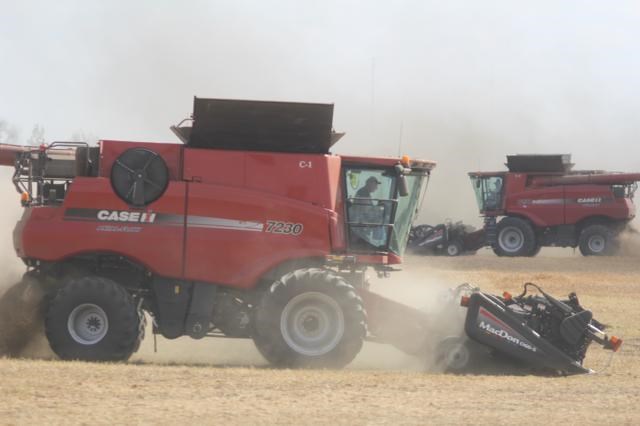Combines and swathers have begun the harvest operations in the southeast region, with Sask. Agriculture reporting three per cent of the crop combined and four per cent in swaths for the week ending Aug. 6.
The five-year average for this time of year is one per cent combined. Provincially, about one per cent of the crop has been combined and two per cent has been swathed, or is ready to be straight-cut, which is close to the five-year average for the province.
Weyburn area farmer Jeff Gaab is well into his harvesting, as he has just finished taking off yellow peas and had started harvest of his lentils crop on Monday.
“We’re quite satisfied with the peas,” he said. “The lentils are variable, ranging from quite nice in places to a lower yield in places. Those spring rains caused a bit of flooding in the field so the yields will be lower in those spots.”
Once the lentils are in the bin, Gaab said his durum crops are getting close to being ready, and the canola crops are also getting close to being swathed.
“It’s going to keep steady from now on, as we’re going to move right into the durum from the lentils, so I think all these crops are going to be ready to go. Hopefully the weather cooperates with us. I think generally harvest should be wrapped up in good time this year,” said Gaab, who farms south of Weyburn. He said the yields so far on his crops is in the average range.
“I’m feeling pretty good about harvest. Everything looks good out here, and I think there will be decent yields and quality,” he added.
Of the crops in the southeast region overall, 22 per cent of the fall rye, 13 per cent of the winter wheat, 20 per cent of the lentils, and 14 per cent of the field peas are now in the bin, while two per cent of the canola has been swathed.
There have been scattered showers throughout the region, with the RM of Tecumseh in the Stoughton region recording 8 mm of rainfall, the RM of Brokenshell recording 3 mm, while the RM of Wellington had 17 mm, and rainfall ranged from 8 to 15 mm in the RM of Francis, and Laurier had between 5 and 9 mm of rain.
Many areas are still very dry, causing crops to advance quickly. More rainfall will help replenish topsoil moisture, but will be too late to help fill this year’s crops.
The estimated yields from this year’s hay crops are 1.5 tons per acre for alfalfa and brome-alfalfa crops, 1.1 tons per acre for both tame hay and wild hay, and 2.2 tons per acre for greenfeed.
The topsoil moisture conditions have worsened due to the hot, dry weather. Topsoil moisture on crop land is rated as 29 per cent adequate, 59 per cent short and 12 per cent very short. Moisture conditions for hay land and pasture topsoil is rated as 22 per cent adequate, 58 per cent short and 20 per cent very short.
Crop district 3ASE, which is the Radville-Minton-Lake Alma area, is reporting that 65 per cent of the crop land and 83 per cent of the hay land and pastures are short or very short of moisture at this time.
Crop yields overall range from average to well below average, but the quality is good so far. The majority of crop damage this past week was due to a lack of moisture, high temperatures and strong winds.



